Blog
Love Versus Hate, Consciousness In Tune With Subconscious
30 May 2022 Mon
Deniz Can analyzes Shilpa Gupta’s work “While I Sleep” in the context of dreams and subconscious.

DENİZ CAN
denizdcan@me.com
While I struggle to find my way in the darkness out of breath, I swiftly turn up on the top of a mountain, by a hillside. Lightning strikes and the rain hits my face. Everything seems to be rolling along in a black and white movie; as the lightning strikes one after another, the thunder follows, and my ears hum with its rage. Suddenly I get the feeling that I’ve found what I was looking for. Just then, with the drift of the wind a huge bed linen in white sticks to my body and to my face like a mask impossible to put off. While I try to breathe, I wake up abruptly. This moment of waking up creates a feeling of dissociation in my body. As I think about whether I had a nightmare and the meaning of what I have seen, I realize what I went through was not “real” and heave a sigh of relief. I look around, everything is normal and apparently, nothing has changed. The effect of the nightmare I had on the life going on outside is zero and this is soul-shattering at least a bit. Slowly, though, I get over this realistic dream and start a new day.
I have gone through the exact opposite so many times. It is impossible for me to forget the earthquake in the morning that everything turned upside down, everything has changed albeit after a peaceful dream. Some events, changes, and transformations push me to question what is real and what is a dream. Shilpa Gupta’s light installation titled “While I Sleep” (2008) evokes a similar dissociation. This is a type of dissociation you experienced only when you confront an unexpected truth or when you face a reality different than the one encountered in a dream; it’s a shift in perception. The neon text in Gupta’s works says, “Every day I wake up to find the world change while I sleep”. The sentence is filled with connotations, and it reminds me of a book by Ursula K. LeGuin titled “The Lathe of Heaven”. In the book, the story changes direction through the dialogue between Mr. Orr who has the gift/curse of changing the world he lives in with his dreams, and Dr. Haber who is an idealist and mildly cuckoo. This story approaches the same themes in Gupta’s work in a different way. SPOILER ALERT. Since his childhood, Mr. Orr is afraid of deep sleep since he has witnessed his nightmares caused several vicissitudes including the deaths of his loved ones. Yet Dr. Haber convinces him that he can control his dreams and the transformation starts. Haber’s intention was to avert misfortunes like environmental catastrophes, overurbanization, and war through the dreams of his patient. The intent of Haber is seemingly benign, he endeavors to find a remedy for the malignancy in the world. However, the transformation starts with a painting on the wall and ends up with an alien invasion. In the end, it becomes clear that controlling the subconscious is not easy as it seems.

Shilpa Gupta, “While I Sleep”, 2008.
Alongside the aforementioned work, in her oeuvre, Shilpa Gupta focuses on subconscious processes leading to discrimination. With Harvard University psychologist Mahzarin Banaji, Gupta investigates the capacity of the human mind to develop unconscious prejudices based on race, gender, and sexual orientation. Through her work, she reminds us how this working mechanism in sleep can change the reality in our daily lives. A frightening awareness… Yet it is also possible to read this work as a call for a more vigilant review of the things we were exposed to in our conscious lives. This awareness might be an important part of refraining from making ourselves, the society we live within, and finally this world unbearable for our own and for others. As Shilpa Gupta expresses through a conscious effort can we find the ways to foster love in a world harboring hatred is pretty easy? Rather than focusing on hate, differences, and fears; highlighting resemblances, the planet we share, and our mutual responsibilities might be a fresh start for all of us.
ABOUT THE WRITER
Deniz Can joined the creative industries in 2011 in Izmir as the program director of KKSM. She realized the first Art Route events in which exhibitions on a monthly-created road map are discussed during visits with the support of local administrations, cultural institutions, and universities. The event series planted the seeds for the experiential art initiative that she co-founded. Can, who continues her works focused on arts and visitor experience in Istanbul, Izmir and abroad, moved to Istanbul to continue her institutional curatorial practice as an independent curator. She carries forward her academic writing skills professionally following the education she received in American Collegiate Institute, Economy Department in Koç University and Masters in Cultural Management at Istanbul Bilgi University



